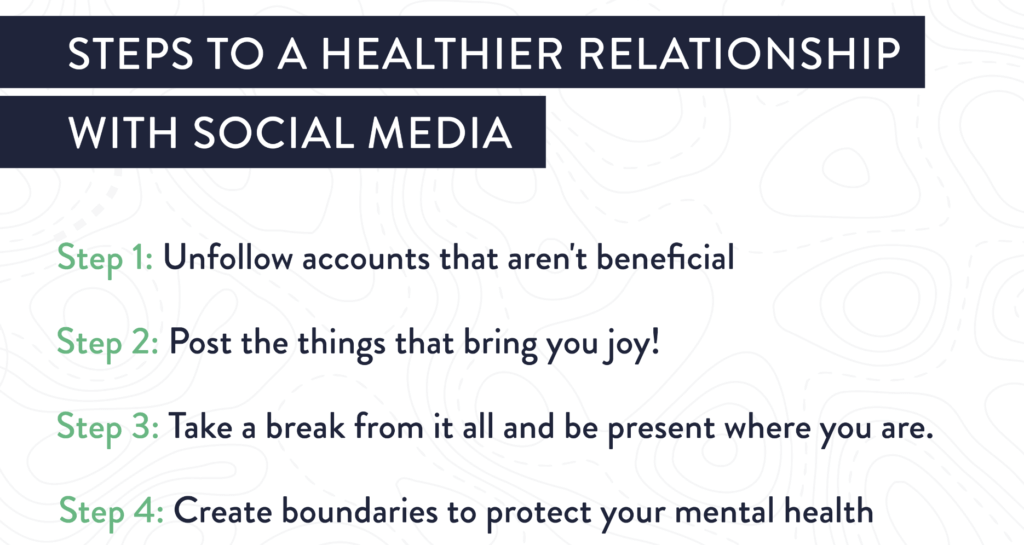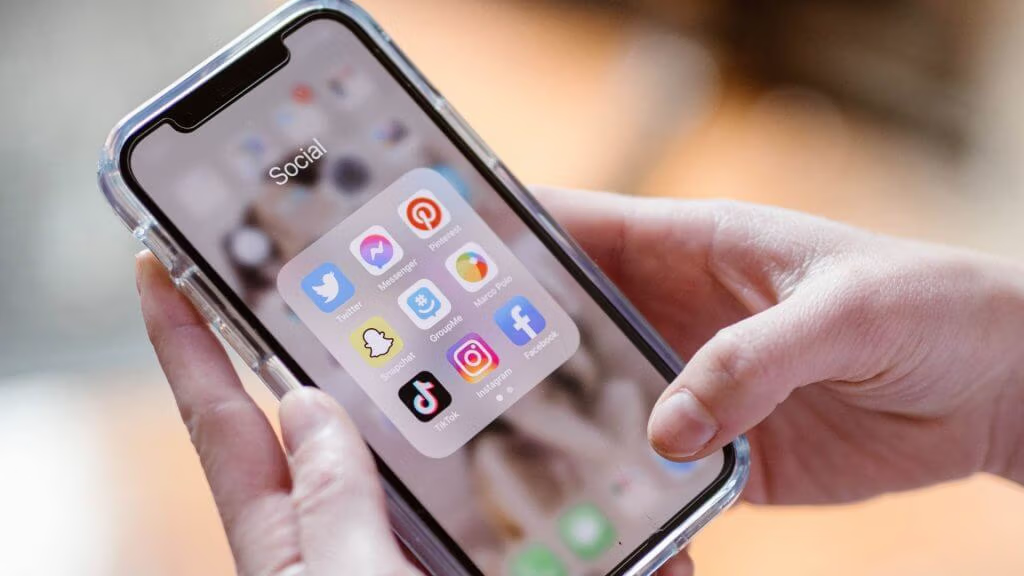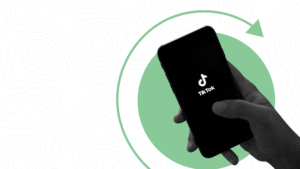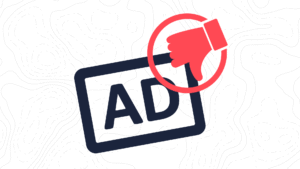I have a love-hate relationship with social media so creating social media boundaries can be tough. I love keeping up with friends from all over the world and from all different times in my life. I love how it gives a platform to those who likely wouldn’t have had one even just 20 years ago. And my favorite part of social media is being able to learn from the lives of people who I’d otherwise have never had the opportunity to interact with.
However, social media isn’t always a positive force in the world. It can be all-consuming; causing us to fall into the trap of comparison or isolationism. You can become addicted to it without even realizing and it can have a big impact on your mental health.
I personally noticed social media becoming more of a problem when it literally became my livelihood. My job is largely to learn about, strategize for, and schedule out social media posts. A large percentage of my day is spent if not on social media then at least thinking about social media. So, when I noticed myself idly grabbing my phone and mindlessly navigating to Instagram as a coping mechanism to deal with boredom, awkwardness, anxiety, or just silence, I knew I had to come up with some boundaries.
Don’t hear me saying that I’ve figured out the perfect balance between real life and online life because I haven’t, but I have found a few tips that have helped me not only separate my work from my personal life but also helped me to use my time online in a more healthy and productive way. There’s no one size fits all approach to this, but maybe some of the things that have benefited me will benefit you as well.
Do a Social Audit
Every few months I take some time to take an audit of my social media accounts, particularly who I’m following. This is a great step in creating social media boundaries.
Remember a few years ago when Marie Kondo and her organization methods were the big thing? One of her major tenants was to touch everything you own and ask yourself if it sparks joy. That’s basically what I do to my follower list. I go through every name and look at their profile and ask myself a few questions:
- Is following this person, business, or group beneficial to me?
- Am I learning or being challenged by them?
- Do I feel encouraged by their content?
- Does it make me happy to be a tiny part of their lives (if it’s a person)?
- Do I feel frustrated, angry, or inadequate when I see them online?
The goal is to help you figure out if it’s worth following a specific account anymore. If that account’s content makes me feel frustrated, angry, inadequate, etc., 9 times out of 10 I unfollow them or at the very least mute them for a period of time. At the end of the day, I have the power over who I follow and if following them is doing harm to me (even if there is good sprinkled in) then it’s not worth following that person.
This is sometimes easier said than done, especially when the people who might be causing you the most issues are people you have a personal relationship with, but I promise you it’s a good decision. If that person’s social media causes you to harbor harsh feelings towards them then it’s better just not to follow them, because remember, oftentimes our online life isn’t the full story.
Avoid Performative Posting
It is incredibly easy for us to curate the perfect social media feed to the point that posting isn’t even fun anymore. I’m not advocating for mindless posting but what I am encouraging you to do is to post the things you enjoy and not worry about performing for an audience.
Social media has given anyone with access to the internet the ability to have a platform. So often we put this unnecessary pressure on ourselves to only post the most perfectly edited pictures with the exact right balance of aloofness and humor in the caption.
On the other side of things we try to only post things that are hot takes or super intellectual or that we think will make people go “mmhmm that’s good!” I struggle more with the second option if I’m being honest. Each of us has to decide what the purpose of our social media presence is and then post accordingly creating social media boundaries.
For example, Instagram is my favorite social media platform and unfortunately one that I think we all struggle the most with. For a long time, I envied the girls I saw with the huge following that made the perfect posts with quotes from their most recent lifestyle blog that just felt oh so relatable to the masses. I hated that they seemed to have so little of substance to say and yet had this huge platform. I wanted a platform too, so I tried to be like them.
I hate to break it to younger me but that just wasn’t going to happen. I didn’t have thousands of followers from college and I didn’t have famous parents to help boost me onto the scene. I didn’t have some revolutionary invention or a cute Etsy shop to promote myself. I just had me and my little blog and the things I enjoyed doing. It took a long time, but eventually, I realized that just me was enough.
For me Instagram is where I capture memories, document my bullet journal, share book reviews, and interact with people I’m encouraged by. I can post about whatever makes me happy and share the things that have encouraged me or that I’ve been learning lately and if people wanted to come alongside me and enjoy those things with me then that was awesome, but if not that’s okay too.
Take a Break
My last little piece of advice is one that you’ve probably heard a million times and are probably bad at just like me. Take a break from all the social noise. This can be as simple or as drastic as you personally need it to be, but whatever you do, take a break.
It’s important to all of us to take a break here and there for a couple of reasons. For one thing, it helps us to be more present in the world around us and with the people around us. It also helps us to destress and can lessen feelings of anxiety. Plus, it encourages us to be more mindful and physically active by reducing mindless scrolling.
Taking a social media break looks different for everyone. It can be a couple of hour break or a whole month. You can completely delete your apps or you can just set your phone aside. Here are a few ways that taking a break might look for you:
- Create social media time limits on your phone and actually stop when it says stop
- Turn off your notifications for social media apps so you’re not as tempted to check it
- Put your phone in another room for a set amount of time to give yourself some physical space
- Pick a day out of the week where you challenge yourself to stay off of social media
- Delete all your social apps for a period of time
Create Social Media Boundaries
My husband can tell you that I am 100% preaching to myself on this one because I’m not really good at this either, but I’m learning that if I’m not intentional in taking social media breaks then it just won’t happen. With my job, I haven’t decided which of the above options would work best for me on a regular basis but I’m working on being consistent and intentional even if the methods change each time.
For example, as I’m writing this in my living room my phone is in my bedroom. My plan for the night is to write a few blogs, do some journaling, and read a book. If I don’t have to touch social for the rest of the night, that would be good with me! Sometimes distance can be the best way to create social media boundaries.

Tips from Our Team
We recently asked our team what kind of tech boundaries they set for themselves and thought we’d share their insight with you:
Set Time Limits on Your Phone
Emily and Slayton both talked about having time limits for the apps they’re prone to overuse. Apple makes this easy to do with their screen time app limits. You can go into your settings and set a time limit for different categories of apps on your phone. iPhone will automatically remind you when you’ve reached your limit and ask you to input a password to continue using those apps. Emily has taken this one step further and had her husband set the password so that even if she wanted to bypass the time limit she couldn’t do it herself.
Limit or Delete the Apps that Zap Your Time
Sara Kate and Beth both suggested limiting the number of apps or notifications that try to pull you in. Sara Kate doesn’t have many personal social media accounts in the first place, but she also deletes the apps that she finds are wasting more of her time than she’d like. Beth suggests limiting the notifications that come through on your phone or apple watch so that you’re not so tempted to jump online every time a notification comes through.
Use Sleep and Focus Mode
All of us agreed that sleep mode is a lifesaver! On iPhone, you can set times for when you want to start winding down for bed. iPhone will turn off notifications and make it ever so slightly more difficult to get on your phone to scroll. At the very least you have to make a more active decision to defy your phone’s bedtime. You can also use this at other times during the week with a separate focus schedule. Brian likes to use his on Sunday mornings while he’s at church to minimize distractions.
It’s become kind of popular in today’s culture to bash social media despite the fact that most of us are using social media in order to bash social media. Ironic, right? That’s really not my goal here. I love social media. I have learned so much and been encouraged by people I otherwise would never have the chance to talk to far less be a part of their lives. However, too much of a good thing can turn bad quickly especially if it’s done thoughtlessly.
Tips from Others
Here are 10 tips via Terkel from other business leaders that they follow to set healthy tech and social media boundaries for themselves:
Create Tech-Free Zones in Your Home
Technology usage is not only associated with application but location, so I implemented healthy boundaries by creating tech-free zones in my living space. Previously, the environment we were in could limit our access to technology, but with the advent of tech mobility, there is almost no place that is off-limits. Therefore, I created tech-free zones in my living space where I do not allow computers, phones, tablets, or other interconnected devices. Whether it is my bedroom, the kitchen, or my backyard, there are certain areas of my living space that I have designated tech-free zones. By doing this, I have created healthy tech boundaries that have relieved stress and kept me from always being connected to my work twenty-four hours a day.
Anthony Puopolo, Rex MD
Bury Apps Annoyingly Deep in Folders
One very bad habit I developed while stuck at home during the pandemic was mindlessly scrolling through social media. YouTube, TikTok, and Instagram became a massive drain on my productivity and mental stimulation. Without thinking, I would pick up my phone, pop open one of the apps, and start scrolling. It was awful, and it was all subconscious. So to prevent this sort of mindless app usage, I buried my social media apps super deep within folders on my phone. I now need to drill down literally 8 folder levels deep to find them. This has the effect of forcing me to think before engaging with them and is insanely annoying. In a way, it’s a self-imposed chilling effect on social media. Don’t get me wrong, social media usage is fine, especially when done purposefully and in short stints, but the type of mindless scrolling I was doing was not good. And burying apps annoyingly deep in folders has helped me to establish better boundaries.
John Ross, Test Prep Insight
Occupy Yourself With Clearly Established Alternative Activities
One of the best ways to set healthy tech boundaries is to make sure you’ve got something better to do versus staying online. It gets really easy to deny the boundaries you previously set – no tech devices after 9 pm for example – if the alternative is doing nothing in particular. You’ve got to have an alternative activity ready to do, and depending on the time of day it could be working, physical activity, or a hobby. Obviously, the more enjoyable your alternative activity is the easier it will be to maintain that tech boundary, but having nothing there at all is a recipe for failure.
Anthony Martin, Choice Mutual
Start With Physical Distance from Your Devices
It may seem like a no-brainer, but not having your phone or laptop within reach automatically limits their usage. When you’re working, try keeping your phone in another room until you’re done. Just the act of heading to a separate room to get your phone can limit any mindless use or overuse of your device. You may also be more motivated to focus on the task at hand and get your tasks out of the way before fetching your device.
Benoit Lacroix, Portmoni
Schedule Time Away from Devices
Build activities into your schedule that make you put your phone away. As a CEO, work never really ends, and the urge to check my email is constant. To combat this, I make sure to schedule at least one thing every day that’s completely tech-free, like workout classes. Creating this separation between me and my devices gives me time to unplug and be fully present in the moment. These boundaries are important to both your physical and mental health.
Rachel Reid, Subtl Beauty
Disable Notifications to Set Healthy Tech Boundaries
I disabled notifications to set healthy tech boundaries for myself. By disabling notifications, I avoid multitasking and focus better at work. My productivity has increased, and so has the depth and quality of my output.
With my notifications disabled, I have set a specific time and length (40 minutes at the most after I eat lunch) to check my phone and answer any messages I receive. When my notifications were still enabled, I would get easily distracted and go down the social media rabbit hole. Because my attention was directed elsewhere, it would take me some time to re-focus on my work.
Ruth Novales, Fortis Medical Billing Professionals
Be Honest With Yourself and Address Any Underlying Issues
It’s impossible to implement healthy boundaries unless you can identify exactly where they are needed. This means being honest with yourself. Most devices have digital well-being options, and apps that allow you to identify your device usage and screen time, as well as to set timers. This can be helpful for maintaining boundaries and avoiding getting distracted by technology. Muting notifications, putting your phone on silent, and taking time to do a digital detox are all beneficial boundaries to consider. However, unless you are honest with yourself about how, why, and when you are most likely to misuse technology, unhealthy patterns will continue to repeat themselves. If you are using social media to distract or numb emotions, for instance, you can then focus on healthier coping techniques such as journaling, mindfulness, or meditation. If tech use facilitates procrastination, then concentrate on addressing this underlying issue in order to inform and enable better boundaries.
Mario Cacciottolo, SBO
Set Rules You Can Actually Follow
Keep your rules realistic. Tech is so ingrained in today’s society that for most people, strict limits aren’t feasible. You can still set boundaries for yourself by cutting back on usage during specific activities. One easy example is meal times; make a rule that you don’t use your phone or laptop while eating. Another option is cutting off screen time after a certain hour in the evenings. By creating tech-free pockets in your day, you give yourself time to disconnect without the strain of unmaintainable rules.
Vimla Black Gupta, Ourself
Step Out as a Way to Enforce Your Set Boundaries
It’s hard to ignore your gadgets while sitting around the house. For this reason, I set two rules for myself. As often as I can, I step outside to not only stretch my legs and breathe some fresh air, but also to fulfill the second rule. That is, I don’t scroll my phone or laptop while walking, chatting with someone out there, commuting, or people-watching. I only answer calls — and when I do, I stop walking and have the entire conversation in one spot. It works. By the time I’m back, I’m naturally too tired for Twitter and YouTube – only family chit-chat over making dinner and I’m off to sleep.
Jon Torres, Jon Torres
Use a Killswitch to Disconnect You at Preset Times
I know, ‘Killswitch’ sounds a bit brutal, but I don’t really know what else to call it. Using a Killswitch has massively helped me set healthy tech boundaries with myself. It’s simply a digital timer (one of the ones you use for lamps). I’ve connected one of these to my router, and set it to disable at a healthy time each night.
Like any boundary, this isn’t all-or-nothing. There have been nights where I’ve adjusted or disabled it. But over the long term, the impact has been incredible. If I’m lost in a rabbit hole on Netflix or on my computer, the switch turning off the internet serves as a way to pull myself back out. It reminds me of my priorities, and it’s saved me from numerous nights where I’d previously be up way too late.
Craig Anderson, Tech Detective
Social media is great when we use it intentionally and with purpose. Hopefully, by putting some of these boundaries into practice it’ll not only help you to have a healthier relationship with social media but also help you to enjoy your time both on and off social media even more!
This content was originally published on March 21, 2022, and was updated with newer information.


